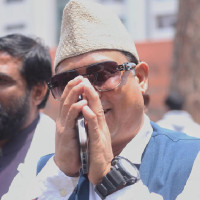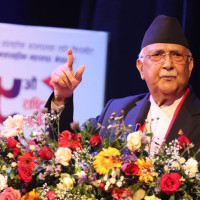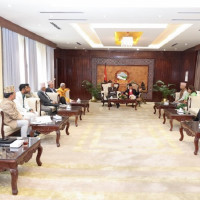- Thursday, 1 May 2025
Construction of 1,061 MW Upper Arun hydropower to be advanced
By A Staff Reporter,Kathmandu, Nov. 4: High-level officials have committed to advancing the construction of the 1,061 MW Upper Arun semi-reservoir hydropower project to be built in Bhotkhola Rural Municipality, Sankhuwasabha district.
A high-level team, including Minister for Finance Dr. Prakash Sharan Mahat, Minister for Energy, Water Resources and Irrigation Shakti Bahadur Basnet, Member of Parliament from Sankhuwasabha Dipak Khadka, Energy Secretary Dinesh Kumar Ghimire, Managing Director of Nepal Electricity Authority Kul Man Ghising, Managing Director of World Bank, which is leading consortium of international organisation for investment in the project, Anna Bjerde and Director General of ADB Ramesh Subramaniam visited the project site on Friday.
In a programme organised at Chograng in Bhotkhola Rural Municipality-4, Finance Minister Dr. Mahat said that the Upper Arun Hydroelectric Project was about to reach the implementation stage.
Despite the limited resources, a good budget has been allocated to take the Upper Arun to the implementation stage, he said, and expressed his commitment that the project would not be affected due to the lack of resources.
He said that the important project for the country has now reached the stage of raising investment and locals would get as many shares as they want for investment.
"The WB has shown special interest in investing in the project, it is trying to raise investment by involving various international financial institutions," said Mahat. "During the World Bank's annual meeting and bilateral discussions, we have emphasised subsidised loans to make the project investment-worthy, and we will have full support from the government to advance the construction by gathering required investment as soon as possible."
Likewise, Energy Minister Basnet said that the government was ready and committed to moving forward the big projects like Upper Arun immediately as this is a time to use water resources for prosperity.
"It has been reported that there is a problem of cutting down the trees for the construction of the access road. According to the court order, we are going to solve the problem of cutting down the trees soon by taking a permission from the Council of Ministers," said Minister Basnet. "We will immediately move forward with the modality of making the locals stakeholders in the project."
Lawmaker Dipak Khadka said that as local residents are always ready to push forward the project, the construction works should start without any delay.
Bjerde, the Managing Director of the World Bank, said that since he came to Nepal, the issue of Upper Arun has been discussed and the electricity produced from the project was important for domestic consumption and export.
Stating that she found that all political parties, including the locals, were eager to move forward with the project, she said that the bank was ready to invest in the project.
The construction cost of the Upper Arun project is estimated at USD 1.75 billion (about Rs. 214 billion), including interest and price increases during the construction period. Of the total cost, 70 per cent will be raised as debt and 30 per cent as equity.
The project to be constructed under the leadership of the NEA is planned to be developed as a model project of 'blended financing'.
The project will include the federal government, provincial government, local levels of the project-affected districts, project-affected district residents, common people from all over the country, concessional loans from international multilateral development partners, and loans from local banks and financial institutions, said the NEA.
In the co-financing led by the World Bank, concessional loans of 750 million US dollars will be collected from international financial institutions. Out of this, the World Bank will provide a subsidised loan of 500 million US dollars.
A plan has been made to manage the finances by raising 400 million dollars from local banks and financial institutions. Under the leadership of Hydroelectricity Investment and Development Company Limited (HIDCL), a memorandum of understanding (MOU) has already been signed to raise investment through co-financing from local banks and financial institutions.
Works are underway to complete the financial management of the project by June 2024 with a goal of starting construction works by the middle of 2025.
The construction of the project is targeted to be completed by 2031.
The feasibility study of the project has been completed and the consultant has been selected for tender design and construction supervision.
Among the preliminary preparations for the project, the construction of about 21 kilometres of access roads, including 2 kilometres of tunnels has started.
The compensation for the acquisition of 2,025 hectares of private land required for the project has been determined. About 22,000 households will be physically displaced by the project. The study has shown that the environmental and social impacts of the construction of the project will be relatively low.
The project is designed to operate at full capacity for 6 hours a day during the 6 months of winter when electricity demand is high. The project will generate 4.51 billion units of energy annually.



-original-thumb.jpg)












